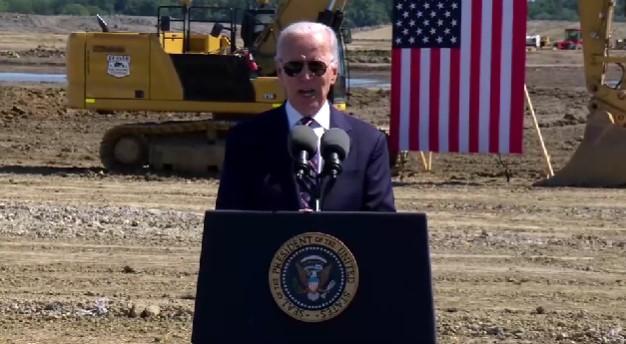President Biden joined Intel CEO Pat Gelsinger Friday at a groundbreaking ceremony for Intel’s $20 billion mega-fab site in central Ohio, marking a new start for domestic chip hegemony and Intel’s newest chip facility in 40 years.
"The industrial Midwest is back," Biden declared, saying it is time to bury the term "rust belt" for a region that started losing manufacturing jobs decades ago to locations abroad and in the South.
Biden praised passage of the CHIPS and Science Act he signed in August for bringing $52 billion to ignite US chips manufacturing with grants and research dollars. He also took credit for creating 668,000 manufacturing jobs since he took office. "Made in Ohio and America is no longer a slogan, it's a reality," he said.
Intel is expected to hire 3,000 professionals to work at the two fabs it will build on the site, which will require 7,000 skilled and union laborers to erect. The area of construction will be 10 football fields in length with construction started 60 feet underground to support four levels, including a floor devoted to the clean room where wafers are converted to millions of chips daily.

Biden and congressional leaders at the groundbreaking event described the need for chips as important to economic growth and national security. "We produce zero of these advanced chips," Biden said. "China is moving well ahead of us...The US has to lead the world and this law makes sure we will..The future of the chip industry is going to be made in America."
Biden said the US needs to continue to strive to have companies that design technology also manufacture it in America. "We will invent it in America and make it in America," he said.
Gelsinger took the stage twice to thank Biden and congressional leaders for working to pass the CHIPS Act, which Gelsinger lobbied for and will directly benefit Intel, up to $3 billion for each of the two fabs currently envisioned on the Ohio site.
Recalling the days Intel's founders helped create Intel in California, Gelsinger said their inspiration is what led companies to create Silicon Valley. Now, with impetus from the Ohio fabs, there will be a Silicon Heartland, a moniker picked up other speakers, including leaders of Ohio-based community colleges and universities.
The groundbreaking on Friday marked an Intel announcement of its Ohio Semiconductor Education and Research Program to pump $17.7 million into eight projects by Ohio higher education institutions, the first phase of a $50 million investment over 10 years. Intel said 2,300 scholarships will be provided with 9,000 students to be educated.
Gelsinger on losing data center share
The occasion was momentus by any measure, but cames one day after Gelsinger told investors at the Evercore SIS TMT conference he expects Intel to continue losing data center market share through at least 2023, then to begin regaining share in 2025 and 2026.
He also said Intel will likely exit other businesses as it has with Optane memory, as described by Paul Alcorn in Tom’s Hardware.
While the comments were not a surprise to the closest Intel observers, they underscore how important manufacturing will be for Intel in coming years to generate revenues, including from third parties that would use Intel’s manufacturing capacity in its incipient foundry operations.
“The foundry business is a boon to Intel in two respects,” said longtime Intel analyst Jack Gold of J. Gold Associates. “First, it’s a way for them to completely fill their fabs, even when their own chips may not be enough to do so. Second, with full utilization of fabs, it provides Intel with an opportunity to invest more on process leadership since they are assured their fabs will remain at full or near full capacity.”
Gold said the foundry business also lets Intel partner with some companies that they may not have much interaction with currently.
Gold said he didn’t think Gelsinger’s comments at Evercore were a real surprise, as Gelsinger spoke about AMD’s momentum in the data center sector. Hyperscalers are also building their own chips, Gold noted. “But the data center market will continue to grow even as the market share for Intel may shrink, so it’s not like Intel doesn’t have great revenue opportunities,” he added.
Intel continues to be hurt by the lack of investments from several years ago. “It will take several years for them to regain the engineering prowess and execution that got them to where they were the leader,” Gold said.
At Evercore, Gelsinger said, according to Alcorn, “We do expect that overall our data center business grows every year as we go forward. From where we are…Q2, Q3 [is] the bottom, but we believe that we’re still losing share at least through next year.
“Competition just has too much momentum, and we haven’t executed well enough, so we expect that bottoming. The business will be growing, but we do expect that there continues to be some share losses. We’re not keep up with the overall TAM growth until we get later in ’25 and ’26 when we start regaining share, material share gains. Now obviously in 2024, we think we’re competitive. 2025, we think we’re back to unquestioned leadership with our transistors and process technology.”
Intel’s core competence is logic chips which helps Gelsinger justify the move away from Optane. “We’re gonna stay out of the memory business and really get a cleanliness of our business strategy around logic,” Gelsinger said. “You know, we have a few more that we’ll likely exit as we continue to prune and get more focused.” Gelsinger didn’t name other businesses to exit.
Gold said the Ohio fab “is about securing the supply chain for both Intel’s internal designs as well as for the foundry business which is going to be important long term. It’s a form of insurance that once completed will let them be less vulnerable to foreign governments and issues overseas.”
RELATED: President Biden signs CHIPS and Science Act: comments and reactions